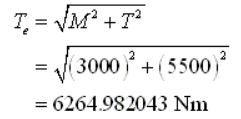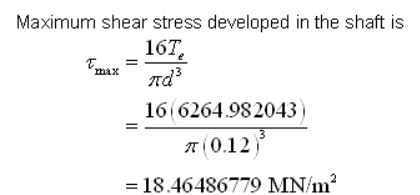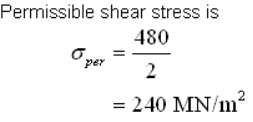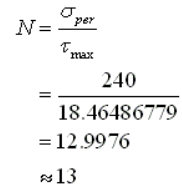Civil Engineering (CE) Exam > Civil Engineering (CE) Questions > A cylindrical shaft of diameter 12 cm is sub...
Start Learning for Free
A cylindrical shaft of diameter 12 cm is subjected to a bending moment of 3 kNm and a twisting moment of 5.5 kNm. If the yield stress of the shaft material is 480 MPa, then the factor of safety of the shaft corresponding to the maximum shearing stress theory of failure is (Answer up to the nearest integer)
Correct answer is '13'. Can you explain this answer?
Most Upvoted Answer
A cylindrical shaft of diameter 12 cm is subjected to a bending momen...
Given data:
Diameter of the shaft (d) = 12 cm = 0.12 m
Bending moment (M) = 3 kNm = 3,000 Nm
Twisting moment (T) = 5.5 kNm = 5,500 Nm
Yield stress of the shaft material (σ_yield) = 480 MPa = 480 × 10^6 Pa
Calculating the maximum bending stress:
The maximum bending stress (σ_bending) in a cylindrical shaft can be calculated using the formula:
σ_bending = (M × c) / I
where c is the distance from the center of the shaft to the outermost fiber and I is the moment of inertia of the shaft cross-section.
For a solid cylinder, the moment of inertia (I) is given by:
I = (π/64) × (d^4)
Plugging in the values, we get:
I = (π/64) × (0.12^4) = 0.001413 m^4
The distance (c) from the center to the outermost fiber is equal to half the diameter, so c = 0.12/2 = 0.06 m.
Now, substituting the values into the bending stress formula:
σ_bending = (3,000 × 0.06) / 0.001413 = 127,322.9 Pa = 127.32 MPa
Calculating the maximum shearing stress:
The maximum shearing stress (τ_shear) in a cylindrical shaft can be calculated using the formula:
τ_shear = (T × r) / J
where r is the distance from the center of the shaft to the point where the shearing stress is being calculated and J is the polar moment of inertia of the shaft cross-section.
For a solid cylinder, the polar moment of inertia (J) is given by:
J = (π/32) × (d^4)
Plugging in the values, we get:
J = (π/32) × (0.12^4) = 0.001131 m^4
The distance (r) from the center to the outermost fiber is equal to half the diameter, so r = 0.12/2 = 0.06 m.
Now, substituting the values into the shearing stress formula:
τ_shear = (5,500 × 0.06) / 0.001131 = 291,150.4 Pa = 291.15 MPa
Calculating the factor of safety:
According to the maximum shearing stress theory of failure, the factor of safety (FS) is given by:
FS = σ_yield / τ_shear
Substituting the values, we get:
FS = 480 × 10^6 / 291,150.4 = 1,649.1
Rounding the factor of safety to the nearest integer, we get FS = 1,649 ≈ 13.
Therefore, the factor of safety of the shaft corresponding to the maximum shearing stress theory of failure is 13.
Diameter of the shaft (d) = 12 cm = 0.12 m
Bending moment (M) = 3 kNm = 3,000 Nm
Twisting moment (T) = 5.5 kNm = 5,500 Nm
Yield stress of the shaft material (σ_yield) = 480 MPa = 480 × 10^6 Pa
Calculating the maximum bending stress:
The maximum bending stress (σ_bending) in a cylindrical shaft can be calculated using the formula:
σ_bending = (M × c) / I
where c is the distance from the center of the shaft to the outermost fiber and I is the moment of inertia of the shaft cross-section.
For a solid cylinder, the moment of inertia (I) is given by:
I = (π/64) × (d^4)
Plugging in the values, we get:
I = (π/64) × (0.12^4) = 0.001413 m^4
The distance (c) from the center to the outermost fiber is equal to half the diameter, so c = 0.12/2 = 0.06 m.
Now, substituting the values into the bending stress formula:
σ_bending = (3,000 × 0.06) / 0.001413 = 127,322.9 Pa = 127.32 MPa
Calculating the maximum shearing stress:
The maximum shearing stress (τ_shear) in a cylindrical shaft can be calculated using the formula:
τ_shear = (T × r) / J
where r is the distance from the center of the shaft to the point where the shearing stress is being calculated and J is the polar moment of inertia of the shaft cross-section.
For a solid cylinder, the polar moment of inertia (J) is given by:
J = (π/32) × (d^4)
Plugging in the values, we get:
J = (π/32) × (0.12^4) = 0.001131 m^4
The distance (r) from the center to the outermost fiber is equal to half the diameter, so r = 0.12/2 = 0.06 m.
Now, substituting the values into the shearing stress formula:
τ_shear = (5,500 × 0.06) / 0.001131 = 291,150.4 Pa = 291.15 MPa
Calculating the factor of safety:
According to the maximum shearing stress theory of failure, the factor of safety (FS) is given by:
FS = σ_yield / τ_shear
Substituting the values, we get:
FS = 480 × 10^6 / 291,150.4 = 1,649.1
Rounding the factor of safety to the nearest integer, we get FS = 1,649 ≈ 13.
Therefore, the factor of safety of the shaft corresponding to the maximum shearing stress theory of failure is 13.
Free Test
FREE
| Start Free Test |
Community Answer
A cylindrical shaft of diameter 12 cm is subjected to a bending momen...
Here, d = 0.12 m, M = 3000 Nm



T = 5500 Nm , σyt = 480 N/mm2
Equivalent torque is

Maximum shear stress developed in the shaft is

Permissible shear stress is

Factor of safety is


|
Explore Courses for Civil Engineering (CE) exam
|

|
Question Description
A cylindrical shaft of diameter 12 cm is subjected to a bending moment of 3 kNm and a twisting moment of 5.5 kNm. If the yield stress of the shaft material is 480 MPa, then the factor of safety of the shaft corresponding to the maximum shearing stress theory of failure is (Answer up to the nearest integer)Correct answer is '13'. Can you explain this answer? for Civil Engineering (CE) 2025 is part of Civil Engineering (CE) preparation. The Question and answers have been prepared according to the Civil Engineering (CE) exam syllabus. Information about A cylindrical shaft of diameter 12 cm is subjected to a bending moment of 3 kNm and a twisting moment of 5.5 kNm. If the yield stress of the shaft material is 480 MPa, then the factor of safety of the shaft corresponding to the maximum shearing stress theory of failure is (Answer up to the nearest integer)Correct answer is '13'. Can you explain this answer? covers all topics & solutions for Civil Engineering (CE) 2025 Exam. Find important definitions, questions, meanings, examples, exercises and tests below for A cylindrical shaft of diameter 12 cm is subjected to a bending moment of 3 kNm and a twisting moment of 5.5 kNm. If the yield stress of the shaft material is 480 MPa, then the factor of safety of the shaft corresponding to the maximum shearing stress theory of failure is (Answer up to the nearest integer)Correct answer is '13'. Can you explain this answer?.
A cylindrical shaft of diameter 12 cm is subjected to a bending moment of 3 kNm and a twisting moment of 5.5 kNm. If the yield stress of the shaft material is 480 MPa, then the factor of safety of the shaft corresponding to the maximum shearing stress theory of failure is (Answer up to the nearest integer)Correct answer is '13'. Can you explain this answer? for Civil Engineering (CE) 2025 is part of Civil Engineering (CE) preparation. The Question and answers have been prepared according to the Civil Engineering (CE) exam syllabus. Information about A cylindrical shaft of diameter 12 cm is subjected to a bending moment of 3 kNm and a twisting moment of 5.5 kNm. If the yield stress of the shaft material is 480 MPa, then the factor of safety of the shaft corresponding to the maximum shearing stress theory of failure is (Answer up to the nearest integer)Correct answer is '13'. Can you explain this answer? covers all topics & solutions for Civil Engineering (CE) 2025 Exam. Find important definitions, questions, meanings, examples, exercises and tests below for A cylindrical shaft of diameter 12 cm is subjected to a bending moment of 3 kNm and a twisting moment of 5.5 kNm. If the yield stress of the shaft material is 480 MPa, then the factor of safety of the shaft corresponding to the maximum shearing stress theory of failure is (Answer up to the nearest integer)Correct answer is '13'. Can you explain this answer?.
Solutions for A cylindrical shaft of diameter 12 cm is subjected to a bending moment of 3 kNm and a twisting moment of 5.5 kNm. If the yield stress of the shaft material is 480 MPa, then the factor of safety of the shaft corresponding to the maximum shearing stress theory of failure is (Answer up to the nearest integer)Correct answer is '13'. Can you explain this answer? in English & in Hindi are available as part of our courses for Civil Engineering (CE).
Download more important topics, notes, lectures and mock test series for Civil Engineering (CE) Exam by signing up for free.
Here you can find the meaning of A cylindrical shaft of diameter 12 cm is subjected to a bending moment of 3 kNm and a twisting moment of 5.5 kNm. If the yield stress of the shaft material is 480 MPa, then the factor of safety of the shaft corresponding to the maximum shearing stress theory of failure is (Answer up to the nearest integer)Correct answer is '13'. Can you explain this answer? defined & explained in the simplest way possible. Besides giving the explanation of
A cylindrical shaft of diameter 12 cm is subjected to a bending moment of 3 kNm and a twisting moment of 5.5 kNm. If the yield stress of the shaft material is 480 MPa, then the factor of safety of the shaft corresponding to the maximum shearing stress theory of failure is (Answer up to the nearest integer)Correct answer is '13'. Can you explain this answer?, a detailed solution for A cylindrical shaft of diameter 12 cm is subjected to a bending moment of 3 kNm and a twisting moment of 5.5 kNm. If the yield stress of the shaft material is 480 MPa, then the factor of safety of the shaft corresponding to the maximum shearing stress theory of failure is (Answer up to the nearest integer)Correct answer is '13'. Can you explain this answer? has been provided alongside types of A cylindrical shaft of diameter 12 cm is subjected to a bending moment of 3 kNm and a twisting moment of 5.5 kNm. If the yield stress of the shaft material is 480 MPa, then the factor of safety of the shaft corresponding to the maximum shearing stress theory of failure is (Answer up to the nearest integer)Correct answer is '13'. Can you explain this answer? theory, EduRev gives you an
ample number of questions to practice A cylindrical shaft of diameter 12 cm is subjected to a bending moment of 3 kNm and a twisting moment of 5.5 kNm. If the yield stress of the shaft material is 480 MPa, then the factor of safety of the shaft corresponding to the maximum shearing stress theory of failure is (Answer up to the nearest integer)Correct answer is '13'. Can you explain this answer? tests, examples and also practice Civil Engineering (CE) tests.

|
Explore Courses for Civil Engineering (CE) exam
|

|
Signup for Free!
Signup to see your scores go up within 7 days! Learn & Practice with 1000+ FREE Notes, Videos & Tests.


















